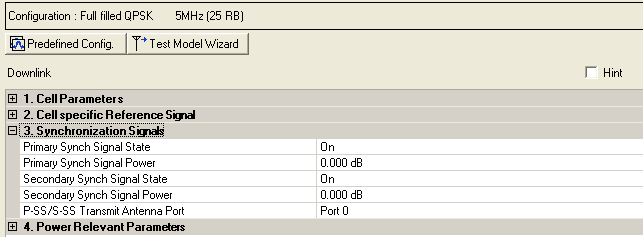
Two types of synchronization signals are used for the downlink in LTE:
Primary synchronization signal (P-SS)
The primary synchronization signal is used to synchronize timing during cell search.
Secondary synchronization signal (S-SS)
The secondary synchronization signal is used to synchronize timing and to transmit cell group identification during cell search.
Additional Downlink parameters are described in Cell Parameters (Basic LTE FDD Downlink), Cell Specific Reference Signal (Basic LTE FDD Downlink), and Power Relevant Parameters (Basic LTE FDD Downlink).

|
3. Synchronization Signals |
|---|
Choice: Off | On
Default: On
The software sets the state of the primary synchronization signal (P-SS) to . You can control the P-SS power as described below.
Range: -60 to 20 dB
Default: 0.000 dB
Enter the power level in dB for the primary synchronization signal, relative to the reference signal per resource element (i.e. when the reference signal power is set to 0 dB).
Choice: Off | On
Default: On
The software sets the state of the secondary synchronization signal (S-SS) to . You can control the S-SS power as described below.
Range: -60 to 20 dB
Default: 0.000 dB
Enter the power level in dB for the secondary synchronization signal, relative to the average subcarrier power..
Choice: Port 0 | Port 1 | Port 2 | Port 3 | All Port
Default: Port 0
Double-click or use the drop-down menu to select the P-SS/S-SS transmit antenna port.
This parameter specifies the antenna port(s) that P-SS and S-SS are transmitted on. P-SS and S-SS can be transmitted on a single antenna (Port0/1/2/3) or all the antenna ports.